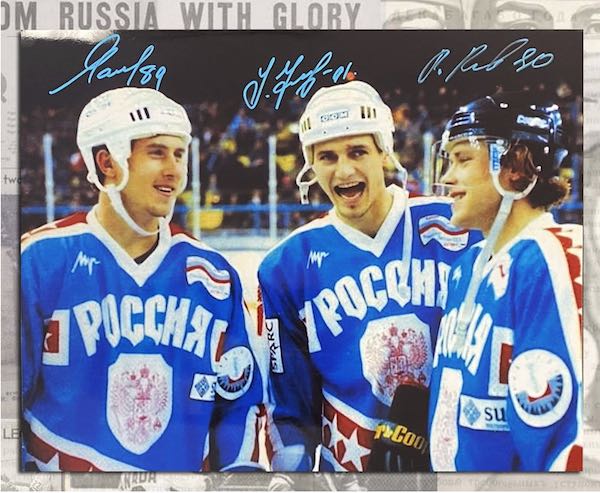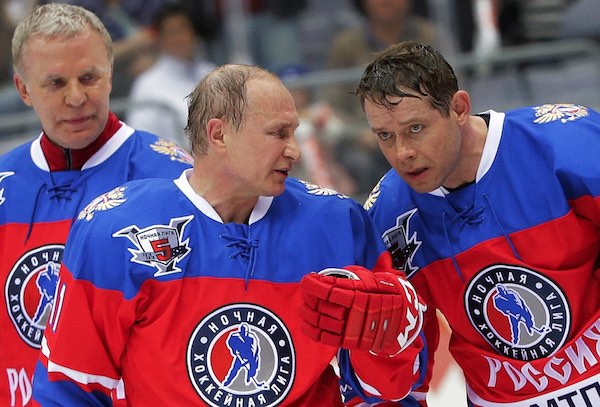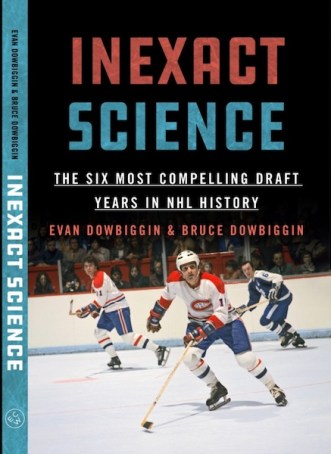Bruce Dowbiggin
When Russians Were Cool: How Detroit Brought Down The Wall

The Ukraine invasion has caused repercussions everywhere— even in hockey. The NHL, IIHF and the CHL have all responded in different ways to punish the aggression shown by Vladimir Putin. The CHL, in particular, has banned the drafting of Russians and Belorussians teenagers in this year’s bantam draft.
This overreach is all the rage with officials offended by Putin (the Metropolitan Opera fired one of its star soloists, Russian Anna Netrebko, for not condemning Putin enough). Not since the 1980s, when the dying USSR forbade the drifting on players into the NHL, has there been such distrust of Russians for political reasons.
In our new book Inexact Science, my son Evan and I recalled how the Detroit Red Wings, under chief scout Neil Smith, cracked the bias against Soviet (Russian) players in the historic 1989 draft as they poached a Hall of Fame defence man from Sweden and two Russian stars— Sergei Fedorov and Vladimir Konstantinov, in the middle rounds of that draft. And how it could have been much greater with a third Russian who got away.
“In 1986, Smith had been sent on a mission to find a full-time European scout for Detroit. Visiting Sweden, he encountered Christer Rockstrom. Smith was already somewhat acquainted with this scouting whiz, because Christer had been the cab driver who would take him to and from games he was scouting. Realizing he was dealing with a hardcore but perceptive fan who knew the players inside and out, Smith persuaded the Wings to give the Swede some scouting employment on a part-time basis, and then promoted him to the full-time European scout role a couple years after. It was a partnership that paid huge dividends.
The results of the organization’s new dedication to searching deeply into Europe was never more evident than with their third-rounder in the 1989 draft. That pick (number 53) may just be the best mid-round steal in NHL draft history. Rockstrom had put in tremendous diligence to find him, alerting his higher-ups to this thin, wiry kid playing for VIK Västerås HK of the Swedish Elitserien. A teenaged defenceman who had drawn into only 20 games in 1988–89 with just two assists to show for it, this player didn’t get much ice time when he actually did find his way into the lineup. Nonetheless, he happened to catch Rockstrom’s eye. That D-man was none other than Nicklas Lidstrom.
Fearing Lidstrom would be lost to them in the 1990 draft, when he’d be considered a first-round-worthy prospect, Detroit pounced a year in advance. Rockstrom convinced the Wings brass to use their last possible chance to grab Lidstrom—a potential gem who he believed would turn into a top pairing defender. Wary that someone could spill the beans to other teams, only four members of the organization—Devellano, Smith, Holland and Rockstrom—knew the secret until the day of his selection.
It worked like a charm. Lidstrom was still available come round three and was taken by the Wings—to the confusion of many in attendance. Even the NHL’s Central Scouting Bureau had very little info on what was considered quite an off-the-board choice (or “project,” as it’s often dubbed today).
As the league scrambled to figure out the Lidstrom pick on the draft floor in Minnesota, the Wings were thinking even further to the east for other delightful discoveries. Once the spring of 1989 rolled around, Soviet authorities had finally begun actively marketing some of their established stars to interested buyers in North America… it was still believed that the Soviets would want to hang on to their elite younger talent for several years to come. This mindset warded off many teams from wanting to “waste” a pick on such an arduous scenario. The Wings were not so easily scared in 1989. Having already passed on grabbing Sergei Fedorov when they had the chance in 1988, they used their fourth-round pick, number 74 overall, to select him the following year.
Devellano certainly wasn’t planning to miss out on Fedorov on this particular occasion. As he told NHL.com in 2015, “My thinking was, ‘Let’s call a spade a spade; how many fourth-round picks who are North American make it big?’ Very few… So what I said to myself was, ‘This is the best 19-year-old in the world, and I’m going to pass on him (again) to probably take a minor-league player?’ Forget about that, he’s coming on the Red Wings’ list, and we’ll worry about it in the future.” A star centre with Moscow CSKA, Fedorov internationally and domestically was featured as the playmaking, defensively responsible force on a line with fellow teenaged phenoms Alexander Mogilny and Pavel Bure—a ridiculously potent grouping that was the equivalent of a 2004 Russian squad icing a line with Evgeni Malkin between Alex Ovechkin and Ilya Kovalchuk.
Mogilny himself had been secured by the Sabres with the 89th overall pick a year earlier, but scouts were salivating that perhaps Bure or Fedorov could be available the next year as well. Fedorov had even been offered the chance to jump ship with Mogilny earlier. Before becoming the first Soviet player to successfully defect, Mogilny revealed his intentions to close friend Fedorov in a Stockholm hotel room they shared. Fedorov rejected the offer to join him, however, figuring it was a lark, prank or some sort of joke that was never supposed to be acted upon. But within 48 hours of the chat, Mogilny bolted the premises in an elaborate escape where he gained contact with the Sabres and the parties enacted a covert flight plan into the USA. While Fedorov stayed put for the meantime, the Wings were undeterred in taking him, even if it made the Soviet authorities keep even stricter surveillance on their prized pupils.
At his team’s drafting table that day (in 1989), Devellano reportedly promised Smith that they could go after at least one more Russian before the day was over. That next one ended up being Fedorov, who many whispered might just have been the best on that line because of his uncanny ability to handle the duties of a two-way centre while the explosive Mogilny and Bure were freed up to earn the glory of scoring most of the goals. Devellano would make his reasoning clear down the road by stating, “As was the case with Petr Klima, my strategy was simple. We would draft the best players, and if they happened to be behind the Iron Curtain, we would use our ownership resources to find a way to get them out.” Such boldness confirms the theory that quality ownership is perhaps the most important element in forging a perennially successful sports club.
Indeed, the Ilitches—who also own the Detroit Tigers—were the polar opposite of what Wings ownership had been under Bruce Norris. Their willingness to use their big dollars, trust their personnel and treat their employees with a degree of loyalty and compassion certainly gave the franchise some incredible mileage in their eventual reign as the model NHL organization from the mid-1990s to the early 2010s. The drafting wizardry of 1989 didn’t necessarily begin and end with the Wings, though. And it could’ve been even richer. While Wings personnel in later years claimed they were ready to grab Fedorov’s linemate Bure with their sixth-round pick and deal with any questions of his eligibility later, they never got the chance to add him. Another team’s plans got in the way.
Detroit’s management group had apparently mused about grabbing Bure in the fifth round after already having secured Fedorov. As Holland told the Toronto Star’s Bob McKenzie in 1995:
We (were) at the draft table and Christer tells Neil “Now we should take Bure”… Neil said he didn’t think Bure had played enough games to be eligible. So Neil goes and checks with (NHL vice-president) Gil Stein, and Stein tells Neil that Bure has only played seven games and it has to be eleven (sanctioned games) to be an eligible pick. Neil comes back and tells us that, and Christer says “No, that’s not right. He played eleven. I know he played eleven.” Neil goes back to Stein and tells him our European scout said Bure should be eligible.
Stein still said no. The NHL’s records showed just five games played in 1987–88—figures Rockstrom believed were erroneous. So Neil comes back to the table and it’s coming to our turn. We didn’t think Bure was eligible, so we took someone else (Shawn McCosh)… Finally, Neil said we were going to take Bure with our next pick no matter what and let the league settle the eligibility thing later. We were just about to pick him when the Canucks announced his name.

It was Canucks GM Pat Quinn who swooped in on Bure during that sixth round (overruling his second-in-command, Brian Burke, who at the time thought Bure was too small for the big leagues of North America). Thankfully for the Canucks, their head scout, Mike Penny, agreed with Rockstrom’s assertion that Bure had made the required number of appearances and convinced his boss to turn in the card with Bure’s name on it. With whispers that the Oilers were looking to nab him too, the Canucks stepped up to make “The Russian Rocket” their own at number 113, and did so only three spots ahead of where the Wings ultimately took Dallas Drake—perhaps Detroit’s most successful North American pick that year, but a far cry from a future Hall of Famer like Bure.
As consolation the Red Wing later nabbed Vladimir Konstantinov in the seventh round. To put the finishing touches on their 1997-98 Stanley Cups they added USSR stars Igor Larionov, Sacha Fetisov and Slava Kozlov. The NHL— and Don Cherry— was never the same after the triumph of the Russian Five
Bruce Dowbiggin @dowbboy is the editor of Not The Public Broadcaster (http://www.notthepublicbroadcaster.com). The best-selling author was nominated for the BBN Business Book award of 2020 for Personal Account with Tony Comper. A two-time winner of the Gemini Award as Canada’s top television sports broadcaster, he’s also a regular contributor to Sirius XM Canada Talks Ch. 167. His new book with his son Evan Inexact Science: The Six Most Compelling Draft Years In NHL History is now available on http://brucedowbigginbooks.ca/book-personalaccount.aspx

Bruce Dowbiggin
The Game That Let Canadians Forgive The Liberals — Again

With the Americans winning the first game 3-1, a sense of panic crept over Canada as it headed to Game 2 in Boston. Losing a political battle with Trump was bad enough, but losing hockey bragging rights heading into a federal election was catastrophic for the Family Compact.
“It’s also more political than the (1972) Summit Series was, because Canada’s existence wasn’t on the line then, and it may be now. You’re damn right Canadians should boo the (U.S.) anthem.” Toronto Star columnist Bruce Arthur before Gm. 1 of USA/ Canada in The 4 Nations Cup.
The year 2025 is barely half over on Canada Day. There is much to go before we start assembling Best Of Lists for the year. But as Palestinian flags duel with the Maple Leaf for prominence on the 158th anniversary of Canada’s becoming a sovereign country it’s a fair guess that we will settle on Febuary 21 as the pivotal date of the year— and Canada’s destiny as well.
That was the date of Game 2 in the U.S./Canada rivalry at the Four Nations Tournament. Ostensibly created by the NHL to replace the moribund All Star format, the showdown of hockey nations in Boston became much more. Jolted by non-sports factors it became a pivotal moment in modern Canadian history.
Set against U.S. president Donald Trump’s bellicose talk of Canada as a U.S. state and the Mike Myers/ Mark Carney Elbows Up ad campaign, the gold-medal game evoked, for those of a certain age, memories of the famous 1972 Summit Series between Canada and the USSR. And somehow produced an unprecedented political reversal in Canadian elections.
As we wrote on Feb. 16 after Gm. 1 in Montreal, the Four Nations had been meant to be something far less incendiary. “Expecting a guys’ weekend like the concurrent NBA All Star game, the fraternal folks instead got a Pier Six brawl. It was the most stunning beginning to a game most could remember in 50 years. (Not least of all the rabid Canadian fanbase urging patriotism in the home of Quebec separation) Considering this Four Nations event was the NHL’s idea to replace the tame midseason All Star Game where players apologize for bumping into each other during a casual skate, the tumult as referees tried to start the game was shocking.
“Despite public calls for mutual respect, the sustained booing of the American national anthem and the Team Canada invocation by MMA legend Georges St. Pierre was answered by the Tkachuck brothers, Matthew and Brady, with a series of fights in the first nine seconds of the game. Three fights to be exact ,when former Canuck J.T. Miller squared up with Brandon Hagel. (All three U.S. players have either played on or now play for Canadian NHL teams.)
“Premeditated and nasty. To say nothing of the vicious mugging of Canada’s legend Sidney Crosby behind the U.S. net moments later by Charlie McEvoy.”
With the Americans winning the game 3-1 on Feb. 15, a sense of panic crept over Canada as it headed to Game 2 in Boston. Losing a political battle with Trump was bad enough, but losing hockey bragging rights heading into a federal election was catastrophic for the Family Compact. As we wrote in the aftermath, a slaughter was avoided.

“In the rematch for a title created just weeks before by the NHL the boys stuck to hockey. Anthem booing was restrained. Outside of an ill-advised appearance by Wayne Gretzky— now loathed for his Trump support— the emphasis was on skill. Playing largely without injured Matthew and Brady Tkachuk and McAvoy, the U.S. forced the game to OT where beleaguered goalie Craig Binnington held Canada in the game until Connor McDavid scored the game winner. “
The stunning turnaround in the series produced a similar turnaround in the Canadian federal election. Galvanized by Trump’s 51st State disrespect and exhilarated by the hockey team’s comeback, voters switched their votes in huge numbers to Carney, ignoring the abysmal record of the Liberals and their pathetic polling. From Pierre Poilievre having a 20-point lead in polls, hockey-besotted Canada flipped to award Carney a near-majority in the April 28 election.
The result stunned the Canadian political class and international critics who questioned how a single sporting event could have miraculously rescued the Liberals from themselves in such a short time.

While Canada soared because of the four Nations, a Canadian icon crashed to earth. “Perhaps the most public outcome was the now-demonization of Gretzky in Canada. Just as they had with Bobby Orr, another Canadian superstar living in America, Canadians wiped their hands of No. 99 over politics. Despite appeals from Orr, Don Cherry and others, the chance to make Gretzky a Trump proxy was too tempting.
We have been in several arguments on the subject among friends: Does Gretzky owe Canada something after carrying its hockey burden for so long? Could he have worn a Team Canada jersey? Shouldn’t he have made a statement that he backs Canada in its showdown with Trump? For now 99 is 0 in his homeland.”
Even now, months later, the events of late February have an air of disbelief around them, a shift so dramatic and so impactful on the nation that many still shake their heads. Sure, hockey wasn’t the device that blew up Canada’s politics. But it was the fuse that created a crater in the country.
Bruce Dowbiggin @dowbboy is the editor of Not The Public Broadcaster A two-time winner of the Gemini Award as Canada’s top television sports broadcaster, his new book Deal With It: The Trades That Stunned The NHL And Changed hockey is now available on Amazon. Inexact Science: The Six Most Compelling Draft Years In NHL History, his previous book with his son Evan, was voted the seventh-best professional hockey book of all time by bookauthority.org . His 2004 book Money Players was voted sixth best on the same list, and is available via brucedowbigginbooks.ca.
Bruce Dowbiggin
Canada Day 2025: It’s Time For Boomers To Let The Kids Lead

So how did you spend your first Canada Day under new PM Mark Carney? If you’re CBC, freed from the clutches of Pierre Poilievere, you do a fawning interview with ex-pat comedian Mike Myers, whose Elbows Up appearance on Saturday Night Live and whose partisan hockey sweater appearance with Carney were pivotal moments in the recent election. (Saving CBC from drastic budget cuts— not that they mentioned it.)
After Donald Trump’s bellicose 51st state comments, Myers’ nostalgic harkening to the days of Gordie Howe and Mr. Dressup pivoted Boomers’ voter preferences in Canada. Soft Quebec sovereigntists petrified by Trump abandoned the Bloc for the Liberals. Progressives ditched the NDP for the Grits. And some wobbly Conservatives moved to Carney’s side, too, after the charm offensive by Myers, who hasn’t lived in Canada since the 1980s.

The result? Liberals vaulted 20 points in the polls and barely missed a majority in their fourth consecutive election win. Boomers were exultant. Their subsidized media was joyous. And the rest of the world asked if Canada was a serious country after the Libs naked substitution of Carney for the loathed Justin Trudeau. After all, hadn’t the U.S. Democrats tried the same thing and been summarily spanked by voters?
More to the point, had Canadian voters missed a great opportunity by sticking their heads in the ground on Chinese gangs using Canada as a drug launch pad, Canadian banks being fined billons for money laundering, immigration flooding social services, cratering GDP and Palestinian protests clogging the streets?
This at a time when the under-50 generation has lost faith in its destiny within Canada. As we wrote in March why are 43 percent of 18-36 male CDNs telling pollsters they would accept U.S. citizenship if they were guaranteed full rights and financial protections? Where upper-class products of liberal education— the future professional class— have taken to wearing keffiyehs to the convocations and demonstrations. Where housing is an unattainable goal in most major Canadian urban centres.
It’s not hard to see them looking at the Mike Myers obsession with a long-gone Canada and saying let’s get out of here. The signs are there. Recently former TVOntario host Steve Pakin attended two convocations. The first at the former Ryerson University, which switched its name to Toronto Metropolitan University in a fit of settler colonizer guilt. The second at Queens University, traditionally one of the elite schools in the nation. Here’s what he saw.
“At the end of the (TMU) convocation, when Charles Falzon, on his final day as dean of TMU’s Creative School, asked students to stand and sing the national anthem, many refused. They remained seated. Then, when the singing began, it was abundantly noticeable that almost none of the students sang along. And it wasn’t because they didn’t know the words, which were projected on a big screen. The unhappy looks on their faces clearly indicated a different, more political, explanation.

“I asked some of the TMU staff about it after the ceremony was over, and they confirmed what I saw happens all the time at convocations. Then I texted the president of another Ontario university who agreed: this is a common phenomenon among this generation at post-secondary institutions.”
At Queens, where Canadian flags were almost non-existent, O Canada was sung, but the message of unrest was clear: “Convocation sends a message of social stability,” Queen’s principal Patrick Deane began in his speech. “It is a ceremony shaped in history. You should value your connection to the past, but question that inheritance. Focus on the kind of society you’d like to inhabit.”
You can bet Deane is not telling them to question climate change and trans rights. As Paikin observes, “if we fail to create a more perfect union, we shouldn’t be surprised when a vast swath of young people don’t sing our anthem the way so many of the rest of us do.” So why are the best and brightest so reluctant to see as future in becoming the new professional class that runs society?
In the Free Press River Page searched the source of their discontent. “If the Great Recession, Covid-19, and the spectre of an artificial intelligence-assisted ‘white collar bloodbath’ has taught the professional class anything, it is that their credentials cannot save them. This insecurity, compounded by the outrageous cost of living in many large cities, has pushed the PMC’s anxieties to the breaking point.
“Add that to the triumph of identity politics in professional class institutions like universities, corporate C-suites, non-governmental organizations, and media—itself a byproduct of inter-elite competition as many have observed—and what you have is the modern left.
“… they’ve already come to the baffling conclusion that there’s no difference between class struggle and child sex changes. More to the point, the socialist mantra “From each according to his ability, to each according to his need” has only ever stood the test of time in Anabaptist sects. It requires a religious devotion to self-sacrifice that is not characteristic of this anxious and hyper-competitive class—as many actual socialists have spent the last decade warning.”

As we wrote in March Boomer nostalgia is a dead end. “It’s time that Canada’s aging elite ceded a greater voice in the national debate to younger voices. They need an intervention of the type Trump is now performing on Canadians addicted to sitting in first class but paying economy. He brought them into a room with the chairs and levelled with them about getting the free stuff they assumed was their right. Defence, security, trade, medical access. He’s the first president to do this in half a century.
And like all people addicted, CDN Boomers don’t want the truth. They want performance theatre, T-shirts and hockey games. They blame Trump for their predicament, caught between grim realities. Will they take the 12 steps? Or will their kids have to tell them the facts as they escort them to the home?” Because we’re now seeing the likely answer to that question everywhere in Canadian society.
Bruce Dowbiggin @dowbboy is the editor of Not The Public Broadcaster A two-time winner of the Gemini Award as Canada’s top television sports broadcaster, his new book Deal With It: The Trades That Stunned The NHL And Changed hockey is now available on Amazon. Inexact Science: The Six Most Compelling Draft Years In NHL History, his previous book with his son Evan, was voted the seventh-best professional hockey book of all time by bookauthority.org . His 2004 book Money Players was voted sixth best on the same list, and is available via brucedowbigginbooks.ca.
-

 Alberta6 hours ago
Alberta6 hours agoAlberta Independence Seekers Take First Step: Citizen Initiative Application Approved, Notice of Initiative Petition Issued
-

 Crime5 hours ago
Crime5 hours agoNational Health Care Fraud Takedown Results in 324 Defendants Charged in Connection with Over $14.6 Billion in Alleged Fraud
-

 Health4 hours ago
Health4 hours agoRFK Jr. Unloads Disturbing Vaccine Secrets on Tucker—And Surprises Everyone on Trump
-

 Bruce Dowbiggin7 hours ago
Bruce Dowbiggin7 hours agoThe Game That Let Canadians Forgive The Liberals — Again
-

 Agriculture2 days ago
Agriculture2 days agoCanada’s supply management system is failing consumers
-

 Alberta1 day ago
Alberta1 day agoCOVID mandates protester in Canada released on bail after over 2 years in jail
-

 armed forces1 day ago
armed forces1 day agoCanada’s Military Can’t Be Fixed With Cash Alone
-

 Crime2 days ago
Crime2 days agoProject Sleeping Giant: Inside the Chinese Mercantile Machine Linking Beijing’s Underground Banks and the Sinaloa Cartel






